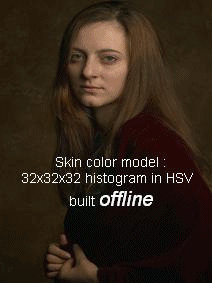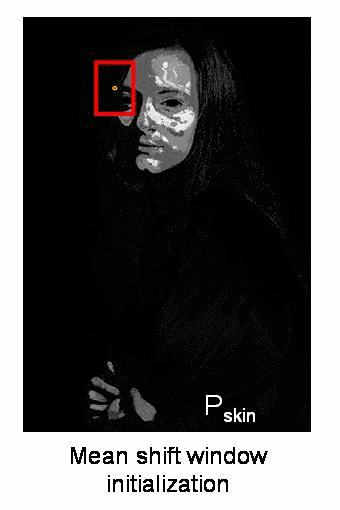1
2
3
4
5
6
7
8
9
10
11
12
13
14
15
16
17
18
19
20
21
22
23
24
25
26
27
28
29
30
31
32
33
34
35
36
37
38
39
40
41
42
43
44
45
46
47
48
49
50
51
52
53
54
55
56
57
58
59
60
61
62
63
64
65
66
67
68
69
70
71
72
73
74
75
76
77
78
79
80
81
82
83
84
85
86
87
88
89
90
91
92
93
94
95
96
97
98
99
100
101
102
103
104
105
106
107
108
109
110
111
112
113
114
115
116
117
118
119
120
121
122
123
124
125
126
127
128
129
130
131
132
133
134
135
136
137
138
139
140
141
142
143
144
145
146
147
148
149
150
151
152
153
154
155
156
157
158
159
160
161
162
163
164
165
166
167
168
169
170
171
172
173
174
175
176
177
178
179
180
181
182
183
184
185
|
Meanshift and Camshift {#tutorial_py_meanshift}
======================
Goal
----
In this chapter,
- We will learn about Meanshift and Camshift algorithms to find and track objects in videos.
Meanshift
---------
The intuition behind the meanshift is simple. Consider you have a set of points. (It can be a pixel
distribution like histogram backprojection). You are given a small window ( may be a circle) and you
have to move that window to the area of maximum pixel density (or maximum number of points). It is
illustrated in the simple image given below:

The initial window is shown in blue circle with the name "C1". Its original center is marked in blue
rectangle, named "C1_o". But if you find the centroid of the points inside that window, you will
get the point "C1_r" (marked in small blue circle) which is the real centroid of window. Surely
they don't match. So move your window such that circle of the new window matches with previous
centroid. Again find the new centroid. Most probably, it won't match. So move it again, and continue
the iterations such that center of window and its centroid falls on the same location (or with a
small desired error). So finally what you obtain is a window with maximum pixel distribution. It is
marked with green circle, named "C2". As you can see in image, it has maximum number of points. The
whole process is demonstrated on a static image below:

So we normally pass the histogram backprojected image and initial target location. When the object
moves, obviously the movement is reflected in histogram backprojected image. As a result, meanshift
algorithm moves our window to the new location with maximum density.
### Meanshift in OpenCV
To use meanshift in OpenCV, first we need to setup the target, find its histogram so that we can
backproject the target on each frame for calculation of meanshift. We also need to provide initial
location of window. For histogram, only Hue is considered here. Also, to avoid false values due to
low light, low light values are discarded using **cv2.inRange()** function.
@code{.py}
import numpy as np
import cv2
cap = cv2.VideoCapture('slow.flv')
# take first frame of the video
ret,frame = cap.read()
# setup initial location of window
r,h,c,w = 250,90,400,125 # simply hardcoded the values
track_window = (c,r,w,h)
# set up the ROI for tracking
roi = frame[r:r+h, c:c+w]
hsv_roi = cv2.cvtColor(roi, cv2.COLOR_BGR2HSV)
mask = cv2.inRange(hsv_roi, np.array((0., 60.,32.)), np.array((180.,255.,255.)))
roi_hist = cv2.calcHist([hsv_roi],[0],mask,[180],[0,180])
cv2.normalize(roi_hist,roi_hist,0,255,cv2.NORM_MINMAX)
# Setup the termination criteria, either 10 iteration or move by atleast 1 pt
term_crit = ( cv2.TERM_CRITERIA_EPS | cv2.TERM_CRITERIA_COUNT, 10, 1 )
while(1):
ret ,frame = cap.read()
if ret == True:
hsv = cv2.cvtColor(frame, cv2.COLOR_BGR2HSV)
dst = cv2.calcBackProject([hsv],[0],roi_hist,[0,180],1)
# apply meanshift to get the new location
ret, track_window = cv2.meanShift(dst, track_window, term_crit)
# Draw it on image
x,y,w,h = track_window
img2 = cv2.rectangle(frame, (x,y), (x+w,y+h), 255,2)
cv2.imshow('img2',img2)
k = cv2.waitKey(60) & 0xff
if k == 27:
break
else:
cv2.imwrite(chr(k)+".jpg",img2)
else:
break
cv2.destroyAllWindows()
cap.release()
@endcode
Three frames in a video I used is given below:

Camshift
--------
Did you closely watch the last result? There is a problem. Our window always has the same size when
car is farther away and it is very close to camera. That is not good. We need to adapt the window
size with size and rotation of the target. Once again, the solution came from "OpenCV Labs" and it
is called CAMshift (Continuously Adaptive Meanshift) published by Gary Bradsky in his paper
"Computer Vision Face Tracking for Use in a Perceptual User Interface" in 1988.
It applies meanshift first. Once meanshift converges, it updates the size of the window as,
\f$s = 2 \times \sqrt{\frac{M_{00}}{256}}\f$. It also calculates the orientation of best fitting ellipse
to it. Again it applies the meanshift with new scaled search window and previous window location.
The process is continued until required accuracy is met.

### Camshift in OpenCV
It is almost same as meanshift, but it returns a rotated rectangle (that is our result) and box
parameters (used to be passed as search window in next iteration). See the code below:
@code{.py}
import numpy as np
import cv2
cap = cv2.VideoCapture('slow.flv')
# take first frame of the video
ret,frame = cap.read()
# setup initial location of window
r,h,c,w = 250,90,400,125 # simply hardcoded the values
track_window = (c,r,w,h)
# set up the ROI for tracking
roi = frame[r:r+h, c:c+w]
hsv_roi = cv2.cvtColor(roi, cv2.COLOR_BGR2HSV)
mask = cv2.inRange(hsv_roi, np.array((0., 60.,32.)), np.array((180.,255.,255.)))
roi_hist = cv2.calcHist([hsv_roi],[0],mask,[180],[0,180])
cv2.normalize(roi_hist,roi_hist,0,255,cv2.NORM_MINMAX)
# Setup the termination criteria, either 10 iteration or move by atleast 1 pt
term_crit = ( cv2.TERM_CRITERIA_EPS | cv2.TERM_CRITERIA_COUNT, 10, 1 )
while(1):
ret ,frame = cap.read()
if ret == True:
hsv = cv2.cvtColor(frame, cv2.COLOR_BGR2HSV)
dst = cv2.calcBackProject([hsv],[0],roi_hist,[0,180],1)
# apply meanshift to get the new location
ret, track_window = cv2.CamShift(dst, track_window, term_crit)
# Draw it on image
pts = cv2.boxPoints(ret)
pts = np.int0(pts)
img2 = cv2.polylines(frame,[pts],True, 255,2)
cv2.imshow('img2',img2)
k = cv2.waitKey(60) & 0xff
if k == 27:
break
else:
cv2.imwrite(chr(k)+".jpg",img2)
else:
break
cv2.destroyAllWindows()
cap.release()
@endcode
Three frames of the result is shown below:

Additional Resources
--------------------
-# French Wikipedia page on [Camshift](http://fr.wikipedia.org/wiki/Camshift). (The two animations
are taken from here)
2. Bradski, G.R., "Real time face and object tracking as a component of a perceptual user
interface," Applications of Computer Vision, 1998. WACV '98. Proceedings., Fourth IEEE Workshop
on , vol., no., pp.214,219, 19-21 Oct 1998
Exercises
---------
-# OpenCV comes with a Python sample on interactive demo of camshift. Use it, hack it, understand
it.
|